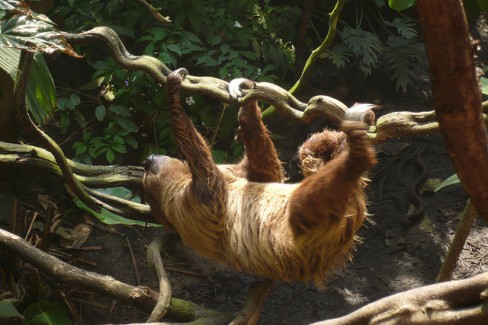
Sloths can be found inhabiting the rainforests of South and Central America. These tree-dwelling mammals are seriously slow moving creatures. At top speed they move around 35 metres a day grazing on leaves as they go and sleeping for around 15-20 hours a day. Interesting sloths are related to anteaters.
They are six different species of sloth – the pygmy three-toed sloth, the pale-throated sloth, the brown-throated sloth, maned sloth, Hoffman’s two toed sloth and Linnaeus’s two-toed sloth. Most have relatively high numbers by the pygmy sloth is critically endangered. There are also a number of extinct species which include aquatic sloths and giant sloths which some believe were the size of elephants.
Sloths are folivores – a type of mammal that specialises in eating leaves, although some of the two-toed sloths have been known to eat insects, some reptiles and even birds. Leaves do not provide a huge amount of nutrients but they have evolved to have slow-acted stomachs which can take up to a month to breakdown their food. To survive on the little energy provided by leaves sloths have a very low metabolic rate which is half of most mammals their size.
Sloths make for an excellent home for other creatures including cockroaches, beetles, fungi and moths which leave in their fur. They are surprisingly clean animals, dropping down from their arboreal homes in the trees to defecate and urinate about once a week in the same spot. They dig a whole with their claws and cover it over afterwards, returning again a week later. This is the time when sloths are most vulnerable to attack from predators.
Females usually bear one baby a year. However, their slow movement does affect their chances of finding a mate at all. Infants cling to the fur of their mother. Occasionally they falls from the trees although the fall rarely results in death due to their solid body structure.
A number of initiatives to save endangered species have been founded including the Aviarios Sloth Sanctuary in Costa Rica that looks after abandoned sloths and reintroduces them into the wild.
To see a sloth for yourself starting planning your trip to the rainforest today.
RELATED: If you are a wildlife lover you shouldn’t miss out on these amazing experiences

